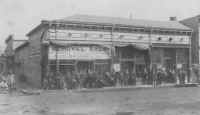| Sharon | |||
Sharon's Yesterdays & Tomorrow An Outline of the Growth of Sharon and its Industries.... and a History of the McDowell National Bank, June 1935
|
|||
|
|
Sharon's Industrial History
Sharon’s
prominence as an industrial center had its beginning with its first
settler, Benjamin Bentley. He built the first
saw mill and grist mil on his place in 1802. The mill was located on the
site of the now closed Stewart Iron Works. The term
“Indian-giver” probably arose from incidents like the following The
Indians traded Mr. Bentley a dog that was half wolf for three bushels of
meal, and, after the meal was consumed, returned for the dog which they
wanted to trade for more meal. They did not get the dog. In 1808
Bentley sold his land and his mill to Samuel Quinby who,
in turn, sold it to Conrad Q. Carver who
operated the mill for many years. The March of Progress is here
illustrated by the fact that the construction of the canal destroyed the
water power which operated the mill, and it was discontinued. The first
blast furnace, the Clay Furnace, was built by Vincent
[&] Himrod in 1845 and was named after Henry
Clay. The same year a furnace was built at West Middlesex. Both
furnaces were the charcoal type. At that
time all furnaces were built in the sides of hills at least as high as the
tops of the furnaces. The ground was leveled off at the top of the hills
to hold ore and fuel. A wagon road was built up the hills for the purpose
of hauling the materials. The
furnace was built of large stones, some of them weighing as much as a ton.
The base of the furnace was about twenty feet square, tapering to the top
to ten or twelve feet. A wooden bridge was constructed, reaching from the
top to the leveled off ground. The bridge was sided, had a roof and was
known as the "bridge house." The
"bridge house" would hold enough fuel for one night and ore
enough for three or four days. The machinery for blowing consisted of
two-cylinder boilers set at the top of the stack in such a manner that the
flame from the furnace passed directly under them. The cylinder was a
large tube made of wood about four feet in diameter. Hot
blasts were then unknown and, when first introduced, were partially heated
from the furnace. In order to economize hear as much as possible part of
the pipe, through which the wind passed, was placed under the boilers.
Other pipes were made in hollow rings or U’s and built in an oven close
to the stack. The oven was fired with stove coal. The idea
of bringing gas from the top of the furnace to the base of the stack was
first considered by Frank Allen, manager of
the Clay Furnace. The blowing cylinders produced a pressure of about three
pounds per square inch and were considered quite powerful. The
average daily yield of iron was about three tons, but occasionally reached
five tons. In 1846 six more blast
furnaces were built. These early furnaces met with many difficulties. The
use of mineral coal was new, and local ores produced an inferior quality
of iron. The yield was small. In 1840 General
Curtis, who was a heavy dealer in coal, decided that an iron
foundry located near his coal would be profitable. At this time there was
labor trouble in Pittsburgh, and General Curtis visited the leaders of the
movement with the idea of having them join his venture. These men visited
Sharon, reported favorably, and stock was subscribed. But, instead of a
foundry, a rolling mill was built, and Sharon was established as an iron
and steel center. In 1850
large bodies of iron ore had been found on the south shore of Lake
Superior, which would yield 90 per cent in bar iron. The first companies
organized to develop Lake Superior ore were not successful, and disbanded
as they could see no money in it. |
East State Street at Shenango Avenue years ago
Related information on:
|
|

